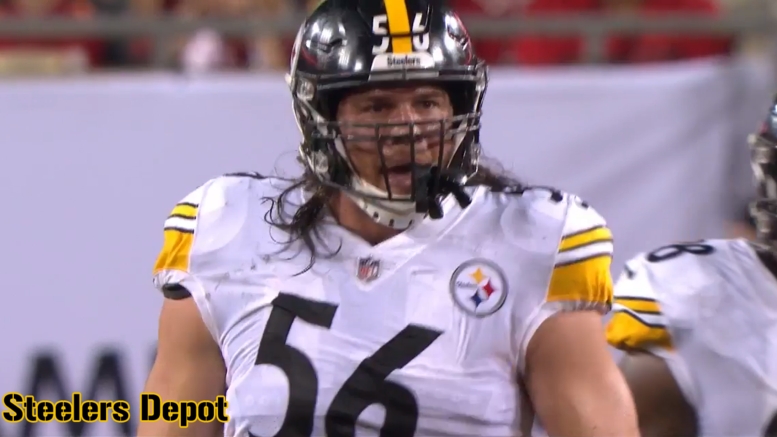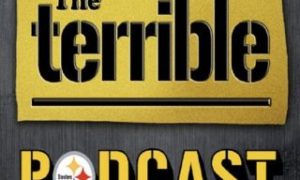It’s said a draft class can’t be fully graded until at least three years after the picks are made. That’s why after submitting grades for every Pittsburgh Steelers pick made in 2021, I began going back through and grading previous Steeler draft classes beginning with 2018. Today continues the fourth class in that exercise, with the Steelers’ second of two sixth-round picks in the 2015 NFL Draft: Anthony Chickillo, a defensive end from Miami (Florida).
This exercise follows the six viewpoints (listed below) for examining and re-grading a pick. Each of the first five viewpoints gets examined and assigned a letter grade, before taking that analysis and combining it into a final letter grade. Those five viewpoints comprise much of what goes into the draft grades consumed by so many every year after the draft.
Steelers’ Career: What did the player contribute to the team that drafted him?
NFL Career: Did the player make the pick look better in hindsight after leaving Pittsburgh?
Pick Value: Did the player outperform his draft slot? Did he fail to live up to the pick used on him?
Positional Value: Was the player the best player remaining at his specific position in the draft?
Other Options: Did any players go during the next round that were better selections?
Overall Grade: A final mark to denote whether the selection was an overall positive one, or one better spent elsewhere.
Each factor in a retrospective doesn’t apply evenly to every pick made; consider the grades weighted. For example, to return a high grade in pick value, a first-round pick should have a long and impactful career, while a later-round pick needs only a couple seasons as a back-up or modest contributor to be worth the selection used on him.
Some factors are universal, though. Whether picked first overall or 259th, there will always be other options on the board to compare the player to, and steals and reaches can come from any place in the draft.
Round 6, Pick 36: Anthony Chickillo, DE, Miami (Florida)
STEELERS CAREER: C
On Day 3 of the 2015 NFL Draft, four of Pittsburgh’s five selections went to defensive players. Of those four, only one spent most of his career as a steady player on the team’s defense, and that was Anthony Chickillo at 212th overall. Pittsburgh immediately picked him up from the line to play more of an outside linebacker role than a defensive end (where he played in college).
His career did not start well and had him on the same path to an early exit that draft mate Doran Grant had. As a rookie, Chickillo ended up on the practice squad to begin his Steeler tenure. A midseason promotion got him on to the active roster and began his NFL snap count, but he numbered only 71 total, 22 of defense. Chickillo was highly productive with that work, though, recording six tackles and forcing a fumble.
That production earned him a promotion to one of the top backup spots on the edge, where he remained the rest of his Steeler career. Added injuries ended up turning 2016 into Chickillo’s biggest opportunity as a Steeler. He started seven games and played in all but one that season. Chickillo forced another two fumbles, made his first career 2.5 sacks, had eight quarterback hits, and also set career highs with 29 tackles and five for a loss. In all but sacks, those remain his career-best numbers.
Chickillo set his new career best in sacks the following season, getting three of them and making 19 tackles. Earning a restricted free agent tender from the franchise and later a two-year contract extension, Chickillo had 43 tackles (four for a loss), two sacks, and two fumble recoveries over 27 games his final two seasons with Pittsburgh. After his fifth season in 2019, the Steelers released Chickillo with one year left on his extension. His final career numbers over four seasons as the primary backup EDGE and one year as a rookie: 97 tackles (11 for a loss), 15 QB hits, 7.5 sacks, three forced fumbles, three fumble recoveries. In three of his five seasons, he surpassed 250 defensive snaps, and played 200-400 special teams snaps in all of his final four years.
NFL CAREER: D+
His first season away from the Steelers was more of the same for Chickillo, though again, it didn’t start out well. Earning a contract from the New Orleans Saints, Chickillo found himself cut and sent to the practice squad by the franchise to begin 2020. The Denver Broncos poached him weeks later, and Chickillo returned to a backup role along the edge. In 11 games for Denver, he had 11 tackles (one for a loss), and one sack. The performance was not enough to earn another contract, and Chickillo remains a free agent hoping for a job at training camp to earn his way on to another roster.
PICK VALUE: B+
Coming dangerously close to going undrafted, Chickillo stuck it out as someone taken right before the final round began. He overplayed his draft slot to secure the top backup spot along the edge, though he never earned a starting job (without other injuries) as Pittsburgh brought in Bud Dupree and T.J. Watt during his career to address the position.
Not only did Chickillo win and hold down that backup job over four of his five seasons, but he was a late sixth-rounder who also received an RFA tender and a contract extension from the franchise. That’s a good return, and a five-year career with his drafting team (and six years overall) is nothing to scoff at and some strong value so late in a weak class beyond the early rounds.
POSITIONAL VALUE: A+
Every Day 3 retrospective from this class so far has made a mention of how poor the depth was in 2015 compared to other years, so it doesn’t need stated at length yet again. At defensive end and outside linebacker, the remaining five players drafted have combined for two fewer starts than Chickillo, exactly one sack, and 55 tackles, compared to Chickillo’s 66.
If you feel the need to know the names, the starts came from Edmond Robinson (232nd, Minnesota), Mark Nzeocha (236th, Dallas), and Brian Mihalik (237th, Philadelphia), and Nzeocha had the lone sack in 2018 while playing for San Francisco. Though not all have been early washouts and have stuck around more than a couple seasons, none have had the level of production and consistent role Chickillo had. Given the position’s alternatives, Pittsburgh made the correct call.
OTHER OPTIONS: B
Chickillo went only 13 picks after L.T. Walton, who looked very poor here in retrospect with the subsequent selections of Darren Waller and Quandre Diggs by other teams. Both of those players went in the small window between Walton and Chickillo, though, so things look better when surveying the 32 players chosen after Pittsburgh picked the Miami defensive end.
Christian Covington (216th, Houston) and Rakeem Nunez-Roches (217th, Kansas City) went to close the sixth round, and have stuck around as backup and occasional starters at defensive tackle. Another name mentioned in Walton’s retro, Austin Reiter (222nd, Washington) started at center in Kansas City for two seasons and won a Super Bowl ring. Also along the O-Line, Bobby Hart (226th, N.Y. Giants) has several years’ experience as a starter at right tackle for the Giants and Cincinnati Bengals.
One big miss enters the picture with the last of those next 32 picks: Trent Brown. A starter for almost all of his 63 career NFL games, Brown began his career with San Francisco before rising to increased prominence with the New England Patriots. That lone season in Foxboro earned him the richest contract for an NFL offensive lineman the following offseason, from the Oakland Raiders. Brown flamed out in two seasons with Oakland/Las Vegas, and the team shipped off his deal back to New England, where he begins this coming season.
OVERALL GRADE: B
Over 200 picks in to a class returning few results this late, Pittsburgh unearthed a player who could take the field for them as a top backup at a key position for almost a half-decade. That is just fine on a selection so late that making the roster is already a win. Chickillo’s career is on its waning moments unless a team picks him up right before camp, but it was a lot longer than the ones of his fellow draft picks this late.








